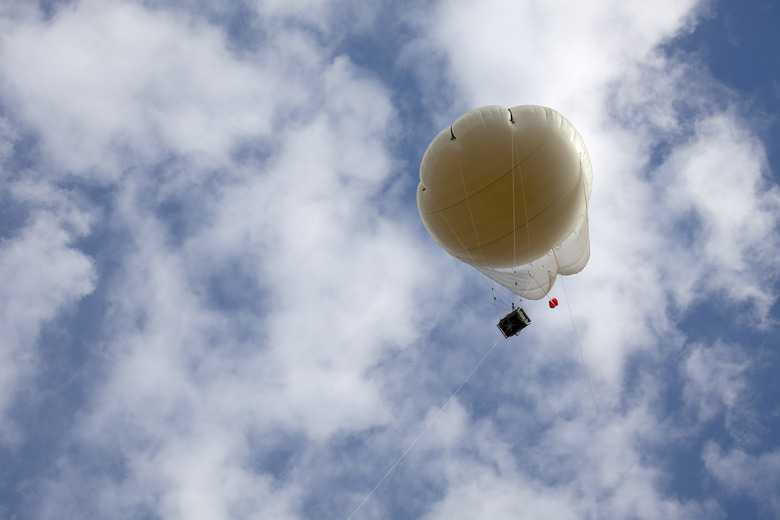Why Do Weather Balloons Expand At High Altitudes?
Even though weather balloons look floppy, small and strange from the outset–like weak floating bubbles–when they reach altitudes of over 100,000 feet (30,000 meters) the balloons are taut, strong and sometimes as big as a house. Starting with the invention of the hot air balloon in the 18th century, balloon flights have made it possible to carry objects high into the sky.
In 1785, the English physician John Jeffries–who often receives credit as the first person to use hot air balloons for scientific purposes–attached a thermometer, barometer and hygrometer (an instrument that measures relative humidity) to a hot air balloon. The balloon reached a soaring height of 9,000 ft (2,700 m) and measured atmospheric data. As of 2010, modern weather balloons reach heights of over 100,000 feet and use helium or hydrogen instead of hot air to rise.
Filling & Rising
Filling & Rising
To launch a weather balloon, meteorologists fill the balloon with either helium or hydrogen, the lightest and most abundant elements in the universe. However, the scientists do not fill the balloon all the way to capacity: when the balloon starts to rise, the balloon casing (or envelope) looks floppy, not taut like a blown-up balloon or hot air balloon.
Scientists do not fill the balloon to capacity for strategic reasons: as a balloon rises into the atmosphere, the pressure around the balloon decreases. The pressure decreases because air gets thinner in higher atmosphere. As the pressure decreases, a balloon fills tight, to its full capacity, to make up for the loss of outside pressure.
Atmospheric Considerations
Atmospheric Considerations
According to Donald Yee, Ph. D from the San Francisco Estuary Institute, at ground level atmospheric pressure is much stronger than it is high up in the thinner atmosphere. If the balloon were completely filled from the start, as the pressure outside the balloon dropped, the balloon would attempt to expand to equalize the pressure, but instead it would pop.
How Weather Balloons Work
How Weather Balloons Work
Meteorologists and scientists use weather balloons to make meteorological measurements in high altitudes. Scientists attach an instrument called a radiosonde to the base of the helium filled balloon. The radiosonde—which measures temperature, humidity and air pressure—transmits meteorological measurements to ground stations through radio transmitters.
Volume
Volume
As a weather balloon rises into high altitudes, where air pressure decreases, the helium or hydrogen pressure inside the balloon increases and expands the balloon. This way the balloon and the radiosonde can rise at a consistent pace high into the atmosphere. Balloons zoom upwards at around 1,000 feet per minute.
Rising Effects
Rising Effects
According to Wendell Bechtold, Meteorologist Forecaster for the National Weather Service in St. Louis Missouri, the balloon ascends to an altitude of around 100,000 feet, enough to see the earth's blue rounded edge from space. By that height, the balloon—depending on the size of the envelope or balloon material—is stretched as wide as a car or house.
When the balloon can no longer stretch outward, and therefore rise further, the balloon ruptures. The gas inside escapes and the radiosonde instrument and busted balloon fall back down to earth. A parachute attached to the instrument prevents damage; however, the balloon cannot be used again.
Retrieval
Retrieval
Before attaching the radiosonde to a balloon, meteorologists insert a small bag inside the radiosonde. Inside the bag is a card telling whoever finds the fallen balloon and instrument what it is and its scientific purpose. That person should mail the radiosonde back to a reconditioning center where scientists read the data, repair any damages and reuse the radiosonde for a future flight.
Cite This Article
MLA
Carver, Noelle. "Why Do Weather Balloons Expand At High Altitudes?" sciencing.com, https://www.sciencing.com/do-balloons-expand-high-altitudes-6400424/. 22 November 2019.
APA
Carver, Noelle. (2019, November 22). Why Do Weather Balloons Expand At High Altitudes?. sciencing.com. Retrieved from https://www.sciencing.com/do-balloons-expand-high-altitudes-6400424/
Chicago
Carver, Noelle. Why Do Weather Balloons Expand At High Altitudes? last modified March 24, 2022. https://www.sciencing.com/do-balloons-expand-high-altitudes-6400424/
